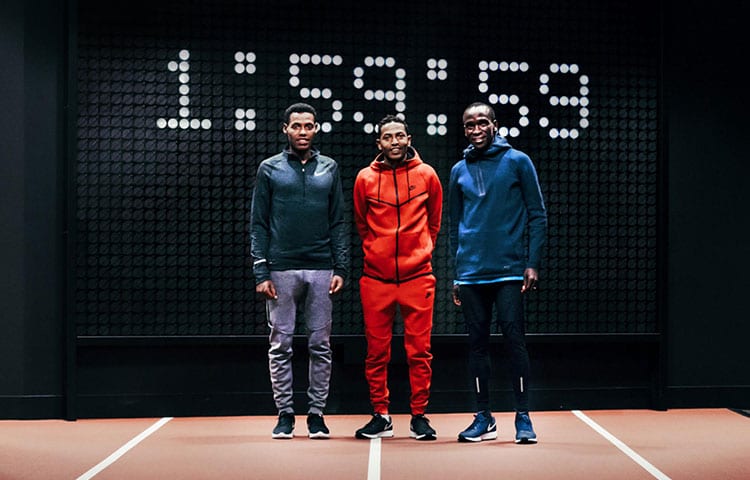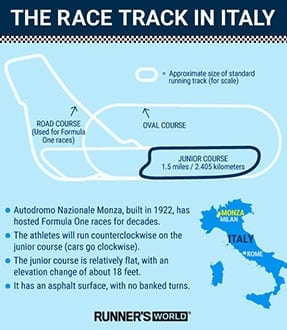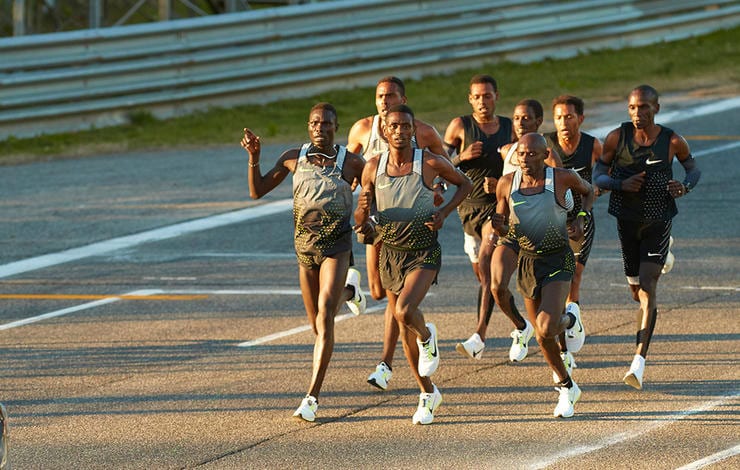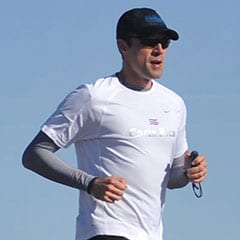
It’s a topic of intense debate among runners: Can a human being run a marathon in under two hours? Nike’s controversial Breaking2 Project aims to answer the question for good May 6 at the Autodromo Nazionale Monza in Monza, Italy. There, three elite marathoners—Lelisa Desisa of Ethopia, Eliud Kipchoge of Kenya, and Zersenay Tadese of Eritrea—will chase running immortality by attempting to become the first person to run 26.2 miles in under 120 minutes.
Notably, May 6 also marks another running milestone: the 63rd anniversary of Roger Bannister breaking the four-minute mile “barrier.” But is a sub-2 marathon in 2017, like the four-minute mile was in 1954, an inevitability? And if so, will history be made in Monza?
Here, with insights from guest contributor and Chief Lunatic Dan Solera, we offer supporting arguments on both sides of the Breaking2 debate. Think a sub-2 will or won’t happen? Share your thoughts in the Comments below!
YAY, a sub-2 marathon will happen in Monza:
1) Running of the G.O.A.T.
 The best and brightest hope for Nike’s Breaking2 aspirations may be Kipchoge. The Kenyan has won the past two Abbott World Marathon Majors Series championships and seven of the eight marathons he’s started including Berlin, Chicago and (twice) London. His personal best of 2:03:05 last year in London stands eight seconds shy of the world record but on a more challenging course. And in a half marathon simulation just last month, he clocked a 59:17 at what he (jokingly?) described as “60 percent” effort. Not only does Kipchoge have the physical tools, but his head is completely in the game and his confidence, passion and willpower are unrivaled. At age 32, he is inarguably at the height of his powers and is one of—if not the—greatest marathoners of all time. There is no athlete in the sport, now or ever, better suited to seize this opportunity.
The best and brightest hope for Nike’s Breaking2 aspirations may be Kipchoge. The Kenyan has won the past two Abbott World Marathon Majors Series championships and seven of the eight marathons he’s started including Berlin, Chicago and (twice) London. His personal best of 2:03:05 last year in London stands eight seconds shy of the world record but on a more challenging course. And in a half marathon simulation just last month, he clocked a 59:17 at what he (jokingly?) described as “60 percent” effort. Not only does Kipchoge have the physical tools, but his head is completely in the game and his confidence, passion and willpower are unrivaled. At age 32, he is inarguably at the height of his powers and is one of—if not the—greatest marathoners of all time. There is no athlete in the sport, now or ever, better suited to seize this opportunity.
2) Freedom is a time trial
The typical marathon isn’t a 26.2-mile “pedal to the metal” endeavor. But just as time trials at the Tour de France feature breakneck speeds not normally seen in other stages, Nike’s experiment will enable its athletes to discard strategy in favor of the one skill at which they certainly excel: running fast. Free from the usual distractions of a competitive marathon, all three men will be empowered to focus their energies on competing not against each other but against their common enemy, the clock. And in contrast to the sharp 90+° turns encountered on the typical road marathon course, Monza’s softer, more gradual turns—the course is, after all, a 2.4-km Formula One racetrack—will allow for more consistent pacing with reduced effort. All of which promises the fastest marathon we’ve ever seen.
3) The three “T”s: talent, training and technology
 Every marathon is a primal event shaped by unpredictability. And no matter how much they train, for most marathoners a perfect, unsullied performance is a black swan event. With that in mind, Nike’s Breaking2 Project strives to minimize this unpredictability by controlling—or at least mitigating—every potential variable of the marathon experience, from training to race day. Taking advantage of the most advanced technology available, Nike scientists have masterminded the day-to-day training and recovery of three of the sport’s most accomplished athletes. Not surprisingly, the company even created a customized version of its newest shoe, the Zoom Vaporfly Elite, for each runner to wear on race day. Never have so many resources and so much attention been dedicated to one marathoner, let alone three. And speaking of minimizing variability…
Every marathon is a primal event shaped by unpredictability. And no matter how much they train, for most marathoners a perfect, unsullied performance is a black swan event. With that in mind, Nike’s Breaking2 Project strives to minimize this unpredictability by controlling—or at least mitigating—every potential variable of the marathon experience, from training to race day. Taking advantage of the most advanced technology available, Nike scientists have masterminded the day-to-day training and recovery of three of the sport’s most accomplished athletes. Not surprisingly, the company even created a customized version of its newest shoe, the Zoom Vaporfly Elite, for each runner to wear on race day. Never have so many resources and so much attention been dedicated to one marathoner, let alone three. And speaking of minimizing variability…
4) Disinviting Mother Nature
Weather is the ultimate race day variable. So it was imperative to find a location with the optimal combination of climate, wind speed and elevation (to ensure maximal oxygen availability). After scouting the globe, Breaking2 scientists are confident they’ve found such a venue in Monza, Italy. They’ve even allowed a three-day window (May 6–8) for race day, to ensure ideal conditions. While Monza’s recent average low and high temperatures on these three days—12.0°C (53.6°F) and 22.5°C (72.5°F), respectively—feel warm for the task, those same days are typically overcast with low humidity. Meanwhile, the track itself sits 600 feet above sea level and boasts little wind, with pacemakers in place to help the runners draft more efficiently and conserve energy. Mother Nature’s disinterest in Monza should go a long way toward ensuring sub-2 success.
NAY, a sub-2 marathon will not happen in Monza:
1) The (un)usual suspects
 If we were to select the three athletes most likely to run a sub-2 marathon, Desisa and Tadese would not make the cut. Instead, we might choose two of Kipchoge’s countrymen: Dennis Kimetto, the current world record (WR) holder, and Wilson Kipsang, a 58:59 half marathoner, winner of four World Marathon Majors and the only man to run a sub-2:04 marathon four times. Although Tadese holds the half marathon WR of 58:23 (seven seconds per mile faster than a 1:59:59 marathon pace), his marathon personal best is an unspectacular 2:10:41. And Desisa, though the youngest of the three (27) and a brilliant tactical racer, has yet to top his 2013 marathon debut of 2:04:45 on Dubai’s notoriously fast course. While Kipchoge is arguably the favorite no matter who runs alongside him, Nike has further shrunk its already narrow margin for error by choosing Desisa and Tadese over Kimetto and Kipsang.
If we were to select the three athletes most likely to run a sub-2 marathon, Desisa and Tadese would not make the cut. Instead, we might choose two of Kipchoge’s countrymen: Dennis Kimetto, the current world record (WR) holder, and Wilson Kipsang, a 58:59 half marathoner, winner of four World Marathon Majors and the only man to run a sub-2:04 marathon four times. Although Tadese holds the half marathon WR of 58:23 (seven seconds per mile faster than a 1:59:59 marathon pace), his marathon personal best is an unspectacular 2:10:41. And Desisa, though the youngest of the three (27) and a brilliant tactical racer, has yet to top his 2013 marathon debut of 2:04:45 on Dubai’s notoriously fast course. While Kipchoge is arguably the favorite no matter who runs alongside him, Nike has further shrunk its already narrow margin for error by choosing Desisa and Tadese over Kimetto and Kipsang.
2) A bridge too far
As talented and accomplished as Nike’s chosen three are, the 178-second leap from the current WR of 2:02:57—already faster than any of the three have run—to 1:59:59 feels more pipe dream than realistic goal. Not since 1952, when Jim Peters ran a 2:20:42 to supplant the WR by nearly five minutes (a 3.4% improvement), has the existing record been eclipsed so convincingly. Moreover, the WR has dropped by only 165 seconds in the past 18 years. So it’s both arbitrary and misleading to compare Nike’s Breaking2 Project, as some pundits have, to Roger Bannister becoming the first man to run a sub-four-minute mile in 1954. Bannister, after all, broke Gunder Hägg’s previous mark by only two seconds. By contrast, a sub-2 marathon will require a 2.5% improvement of nearly seven seconds per mile over the current record. And one mile is not 26.2.
3) Money can’t buy (sub-2) happiness
 No team is better suited to help athletes test their limits than Nike. The company’s deep pockets afford nearly unlimited access to cutting-edge medical technologies and scientific innovation. When it comes to a sub-2 marathon in Monza, however, it will take more than the power of the Swoosh to “just do it.” Because it’s not necessarily a lack of technology that’s limiting marathon performance; rather, it’s our incomplete understanding of the human body and how to improve performance with the available technology while still playing by the rules. Enhancing the body’s ability to dissipate heat is one key example. From a biological perspective, we’re still years away from assembling all the pieces to the sub-2 puzzle. And the best running shoe on the planet isn’t going to change that.
No team is better suited to help athletes test their limits than Nike. The company’s deep pockets afford nearly unlimited access to cutting-edge medical technologies and scientific innovation. When it comes to a sub-2 marathon in Monza, however, it will take more than the power of the Swoosh to “just do it.” Because it’s not necessarily a lack of technology that’s limiting marathon performance; rather, it’s our incomplete understanding of the human body and how to improve performance with the available technology while still playing by the rules. Enhancing the body’s ability to dissipate heat is one key example. From a biological perspective, we’re still years away from assembling all the pieces to the sub-2 puzzle. And the best running shoe on the planet isn’t going to change that.
4) Competition: every Ali needs a Frazier
Competition fuels historic performances. And yet competition is the key ingredient that will be missing from the Breaking2 experiment in Monza. Studies (e.g. here and here) demonstrate a simple but powerful truth: athletes subconsciously perform better when competing against other athletes than when competing alone. Observe the lead pack at any major marathon and you’ll see the benefits of competition, with the leaders jockeying for position and surging in an attempt to pull away from the pack. By pitting its three runners against the clock rather than against each other, Nike has effectively excluded the most crucial element of any athletic competition: the competition itself. And as the miles tick off in Monza, this tactical disregard for our hardwired social instincts may prove to be a critical error.
Whether you view Nike’s Breaking2 endeavor as legitimate sporting competition or marketing spectacle, there’s no doubt all eyes will be on Monza on May 6. And in the event that a sub-2 marathon proves elusive this time, one thing is certain: this will not be a one-and-done. We would expect the Breaking2 Project Run to become an annual tradition, much like any other road marathon. And not to be outdone, Adidas recently launched its own Sub2 program.
For his part, Kipchoge remains confident. “Athletics is not so much about the legs,” he reflected before his winning performance at last year’s London Marathon. “It’s about the heart and mind.”
Kipchoge’s words underscore the ultimate X factor in the Breaking2 challenge: the pursuit of immortality. All the VO2 max measurements in the world can’t quantify each athlete’s hunger to forever etch his name into the sport’s prestigious history. If one of these three men can overcome the artificial sterility of this exercise, he may discover an untapped gear and silence all the skeptics. Alternatively, awareness of the qualifying asterisk that would surely accompany sub-2 success in Monza might subconsciously sabotage an all-out effort. Just ask Kenya’s Geoffrey Mutai, whose 2011 Boston Marathon time of 2:03:02 was denied official WR status due to Boston’s disqualifying (downhill, point-to-point) course. As Ed Caesar writes in Two Hours: The Quest to Run the Impossible Marathon, it was a rebuff that irked Mutai for years.
What is certain is that we’ll know soon enough whether science and audacity will triumph over the sport’s maddening tendency for slow, gradual progress. Stay tuned!

About our Chief Lunatic:
 Dan Solera was bitten by the running bug in 2009 and hasn’t looked back. At any given point he is training for his next big race, which will likely contribute to his goal of running a marathon in all 50 states. His love of running is matched only by his predilection for heavy metal, skiing and writing, interests which seldom intersect. His dream is to take a three-month summer sabbatical and travel through Europe, running races in every major city until his medal rack is flush with mementos from the Old World. Follow along with his marathon musings at dans-marathon.com.
Dan Solera was bitten by the running bug in 2009 and hasn’t looked back. At any given point he is training for his next big race, which will likely contribute to his goal of running a marathon in all 50 states. His love of running is matched only by his predilection for heavy metal, skiing and writing, interests which seldom intersect. His dream is to take a three-month summer sabbatical and travel through Europe, running races in every major city until his medal rack is flush with mementos from the Old World. Follow along with his marathon musings at dans-marathon.com.
Find this article informative or entertaining? Please share it, and let others know RaceRaves is the premier online resource to DISCOVER, REVIEW & TRACK all their races and to CONNECT with other runners!
Other RaceRaves articles you’ll enjoy (trust us!):
10 Presidential Races of the U.S. (PROTUS)
Getting to know the Abbott World Marathon Majors
7 Quick Picks for 2017
2016: The Year in Racing
Race Day Tips (Part Two)
Race Day Tips (Part One)
5 Half Marathon Series worth a full look
Toughest road marathons in the U.S. & Canada
The race every runner should run
interesting read.
Insofar as Nay #1) The unusual suspects: Nike chose Desisa and Tadese over Kimetto and Kipsang. Nike chose from among Nike sponsored athletes. Pretty sure Kimetto & Kipsang run for Adidas and so could not be considered for the Nike project. They may participate in the Adidas project you mention??
Thanks Concrete, you make a great point – Nike definitely chose from among their sponsored athletes. Problem was, it was clear even before the race began that only one had a realistic shot at sub-2. In an ideal world (which Nay #1 admittedly speaks to), the folks at Nike would have been selecting from the entire pool of elite runners, rather than being limited to their own athletes. And both Kimetto and Kipsang do indeed run for Adidas, so here’s hoping we see them both when Adidas rolls out their own version of this experiment!